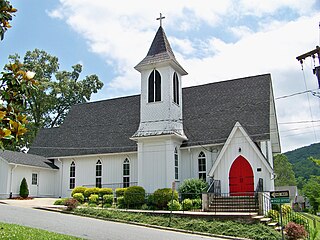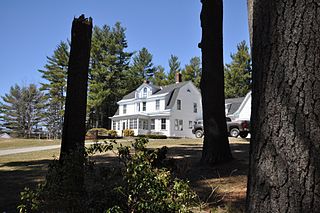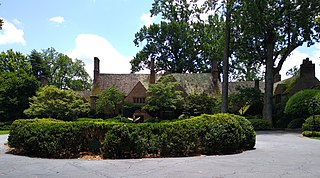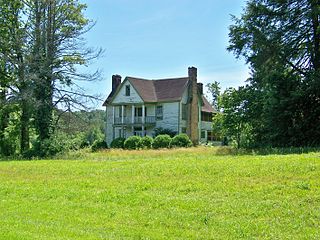
The John Davis House is a historic home located at Fayetteville, Cumberland County, North Carolina. It was built about 1870, and is a two-story, three bay, frame dwelling Late Victorian style ornament. It rests on a brick pier foundation and has a gable roof with flared eaves. The front facade features a one-story shed roof porch, supported by four chamfered posts with lacy sawn brackets.

St. John's Episcopal Church is a historic Episcopal church located at 315 S. Main Street in Marion, McDowell County, North Carolina. It was built in 1883, and is a one-story, Carpenter Gothic style frame church. It has a steeply pitched gable roof, board and batten exterior walls, lancet windows, and an elaborate bell tower added in 1903. St. John's is one of the few buildings that survived the 1894 fire on Main Street. St. John's Episcopal Church is a vibrant spiritual Community with roots formed more than a Century ago.

The William Jennings Bryan House is a historic home located at 107 Evelyn Pl. in Asheville, Buncombe County, North Carolina. It was designed by architects Smith & Carrier and built in 1917. It is a two-story, five bay, side-gable roofed dwelling in the Colonial Revival style. This was the home of William Jennings Bryan from 1917 until he sold the house in 1920.

Foothill Farm is a historic farmhouse on Old Troy Road in Dublin, New Hampshire, United States. Built about 1914 as part of the large Amory summer estate, it is a distinctive local example of Dutch Colonial Revival architecture. The house was listed on the National Register of Historic Places in 1983.

John Alexander Lackey House is a historic home located at Morganton, Burke County, North Carolina. It was built about 1900, and is a two-story, "T"-shaped, gable roofed, brick farmhouse. It has a one-story, gabled kitchen wing. The house features Colonial Revival style detailing.
Taylor-Utley House is a historic home located at Fayetteville, Cumberland County, North Carolina. It was built about 1848, and is a 2+1⁄2-story, three bay, gable roofed frame dwelling in a vernacular Greek Revival style. It has a two-story wing added in 1932.

Barge's Tavern is a historic tavern building located at Fayetteville, Cumberland County, North Carolina. It was built about 1800, and is a 1 1/2-story, three bay, frame building with a gable roof and central chimney. A gable roofed porch and rear ell were added in the late-19th century. It was moved to its present site behind the Belden-Horne House in 1978.
Riley Everhart Farm and General Store is a historic farm and general store located near Welcome, Davidson County, North Carolina. The main house was built in 1885, and is an I-house that consists of a two-story, three bay by two-bay, brick main block with a two-story rear ell with Italianate style design elements. It has a one-story front porch and one-story porches on the ell. The Arnold General Store and Post Office is a tall, narrow two-story, three bay, frame building with a gable roof. Also on the property are the contributing original brick dairy and wellhouse, original log barn, granary, gear house, corn crib, woodhouse, chicken house, and garage.
The Barracks is a historic plantation house located at Tarboro, Edgecombe County, North Carolina. It was built about 1858, and is a two-story, brick dwelling with Greek Revival and Italianate style design elements. It features a central projecting bay with distyle pedimented portico. The portico has fluted columns and a frieze. The house is topped by a cross-gable roof and cupola.

Hoffman-Bowers-Josey-Riddick House is a historic home located at Scotland Neck, Halifax County, North Carolina. It was built in 1883, and is a 2+1⁄2-story, rectangular, frame dwelling with Stick Style / Eastlake movement design elements. It has a complex polychromed, slate roof gable roof; three-story central tower with hexagonal roof; and one-story rear ell. It features a front porch with sawn balustrade.

Erle Stillwell House is a historic home located at Hendersonville, Henderson County, North Carolina. It was built in 1926, and is a two-story, L-plan Tudor Revival style brick dwelling. It has a multi-gable and hip roof with flared gable ends and two brick chimneys with chimney pots. The entrance and sun porch are covered by ribbed copper roofs. It was designed and built by locally prominent architect Erle Stillwell, who built the neighboring Erle Stillwell House II in 1935.

Bishop John C. Kilgo House is a historic home located at Charlotte, Mecklenburg County, North Carolina. It was built in 1915, and is a two-story, three bay, frame dwelling with Colonial Revival and Bungalow / American Craftsman design elements. It has a hipped roof, cubic main block with a later, 1950s rear, two-story, two-bay, gable-roofed addition. The front facade features a center bay, one-story entry porch with Tuscan order columns. It was built for Bishop John C. Kilgo (1861–1922), bishop of the Methodist Episcopal Church, South.

Morrocroft is a historic home located at Charlotte, Mecklenburg County, North Carolina. It was designed by architect Harrie T. Lindeberg and built between 1925 and 1927. It is a Colonial Revival/Tudor Revival style brick manor house. It consists of a main two story block with rambling 1+1⁄2-story side wings. It is characterized by picturesque massing, rhythmic spacing of mullioned, multipaned grouped windows, and numerous multi-stack chimneys rising from steeply pitched gable roofs. It was built by North Carolina Governor and Congressman Cameron A. Morrison (1869-1953).
Holly Bend, also known as Hollywood, is a historic plantation house located near Huntersville, Mecklenburg County, North Carolina. It was built between 1795 and 1800, and is a two-story, five bay by two bay, frame dwelling with Federal style design elements. It has gable roof, brick exterior end chimneys, and a one-story, full-width, hip roof porch.

John Steele House, also known as Lombardy, is a historic plantation house located at Salisbury, Rowan County, North Carolina. It was built between 1799 and 1801, and is a two-story, three bay, side hall plan, Federal style frame dwelling. It has a side gable roof, one-story shed roof porch, and is sheathed with beaded weatherboards. The house was restored between 1977 and 1983. It was the home of North Carolina politician John Steele (1764-1815).
Isaac Williams House is a historic home located near Newton Grove, Sampson County, North Carolina. The farmhouse was built about 1867, and is a one-story, double-pile, five bay-by-four bay, transitional "Triple-A" frame dwelling, with Greek Revival style design elements. It has a prominent front cross-gable roof and hip roofed, three bay, front porch. A 1+1⁄2-story rear ell was added about 1980. Also on the property are the contributing servants quarters, family cemetery, and surrounding fields and woodlands.

Flem Galloway House is a historic home and national historic district located near Calvert, Transylvania County, North Carolina. It was built in 1878, and is a two-story, heavy timber frame I-house, with a two-story rear ell. It is sheathed in weatherboard and has a gable roof. The front facade features a two-tiered, center-bay, cross-gabled porch. Also on the property is a contributing 1+1⁄2-story smokehouse.
Lane-Bennett House, also known as the Joe Bennett House, is a historic home located near Raleigh, Wake County, North Carolina. The original section was built in 1775, and is a one-story, "L"-shaped, Georgian-style frame dwelling. The original three bay section is covered by a very steep gable roof and has a shed roofed front porch. The house was moved to its present location in 1980, along with a contributing smokehouse, and subsequently restored.

Christopher Apple House, also known as the Apple Farm House, is a historic home located in Lawrence Township, Marion County, Indiana. It was built in 1859, and is a two-story, four bay Federal style brick dwelling with Greek Revival style design elements. It has a side gable roof and 1+1⁄2-story rear wing.

Johnson–Denny House, also known as the Johnson-Manfredi House, is a historic home located at Indianapolis, Marion County, Indiana. It was built in 1862, and is a two-story, five bay, "T"-shaped, frame dwelling with Italianate style design elements. It has a bracketed gable roof and a two-story rear addition. It features a vestibule added in 1920. Also on the property is a contributing 1+1⁄2-story garage, originally built as a carriage house. It was originally built by Oliver Johnson, noted for the Oliver Johnson's Woods Historic District.


















